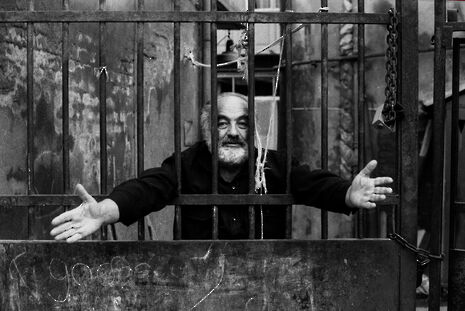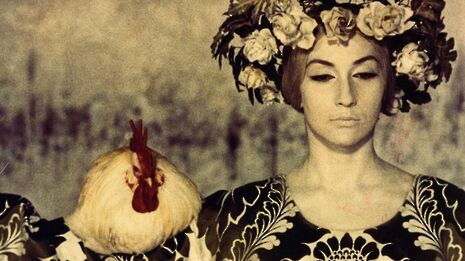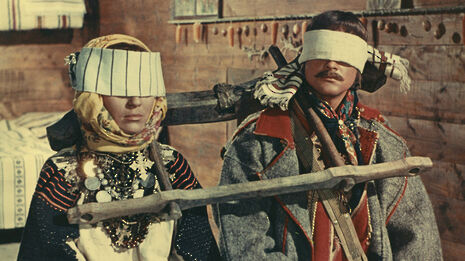Found in translation: a new Russian artistic generation
In the first of her columns, Madeleine Pulman-Jones turns to the finer films of the Soviet Union, paying particular focus to the works of Sergei Parajanov, commonly regarded as Georgia’s greatest visual poet

The hours are passing. We debate important things. Politics, art, kebab shops, cinema. The ash in the ashtray no longer resembles ash, but has formed its own mountain range. I am staying with friends in an ‘art commune’ in the centre of Moscow. Before I came, I was told that it “used to be” a squat; however, after a resident young artist informed me that the director of an avant-garde horror film set in Moscow squats often gives impromptu lectures in the ‘flat’ below, I begin to question whether “used to be” was a white lie. It is two o’clock in the morning and we have just come in from the birthday party of my friend’s possible future collaborator (a film student at VGIK). Our task is as intense and imperative as our environment. We need to choose a film to watch.
"The rooms and studios in the commune were littered with Parajanovian visual quotes"
Excited and passionate, our suggestions soon become ridiculous and impractical, and catering to an audience including a non-English speaking Russian, a broken-Russian speaking Brit and two bilingual Russians proves a challenge. Our criteria are simple: Russian audio with English subtitles, or vice-versa. The process takes another hour. “Parajanov? I’ve only ever seen one Parajanov film,” I venture, “The Colour of Pomegranates, but Katya says that Shadows of Forgotten Ancestors is beautiful. Is it any good?” There is silence. My friend replies, “It’s Parajanov. It’s perfect.” (We had forgotten at this point that it is in Ukrainian, but by the time the projector is set up we are too excited to care.)
It came as no surprise to me that we had arrived at Sergei Parajanov. The rooms and studios in the commune were littered with Parajanovian visual quotes – a dried bouquet of wildflowers pinned to a wall, a Georgian metal icon perched on a shelf, pieces of velvet clothing from Uzbekistan or Armenia littering the floor.

Born in Soviet Tbilisi to an artistic family of Armenian descent before forging a cinematic career in the USSR, the iconoclastic pan-Caucasian auteur became a pioneer of lyric cinema. His rejection of social realism, as well as his unorthodox lifestyle, led to almost all of his work being banned when originally released in the USSR. Eventually, Parajanov was arrested and served four years of hard labour for fabricated charges of rape, homosexuality, and bribery.
"Though previously regarded as deliberately obscure, the film remains accessible and exciting"
Despite the Soviet establishment’s attempts to sabotage Parajanov’s career, his pursuit of freedom of expression embodies a utopian bohemian ideal to this day. With the current artistic and social constraints under Putin and his increasingly nationalistic rhetoric, the provocative, liberal filmmaker is more appealing than ever to young post-Soviet artists.
Sitting in silence after the film that night, the potency of Shadows of Forgotten Ancestors, Parajanov’s celebration of Ukrainian Hutsul culture, was palpable. In 2014, little more than a mile away from the commune, the treaty initiating Crimea’s accession to the Russian Federation had been signed.
The film which remains Parajanov’s most influential and controversial work is 1969’s The Colour of Pomegranates. His aim was to narrate the life of Armenia’s national poet, Sayat-Nova, in a way that borrowed from and translated to the screen the essence of Sayat-Nova’s own poetry. Almost entirely without dialogue, a mixture of still lifes, tableaux and abstract scenes saturated in deep colour depict Sayat-Nova’s life in eighteenth-century Armenia. Though previously regarded as deliberately obscure, the film remains accessible and exciting even to a modern audience totally unfamiliar with Parajanov’s work, or with its source poetry.

However, those looking to The Colour of Pomegranates as a traditional biopic will not find a traditionally presented timeline of the poet’s life. At first viewing, Parajanov’s magnum opus is simultaneously elusive and lucid – an experience somewhere between the state of dreaming and having a dream explained to you by someone else.
It is hard to find a more hypnotic and mysterious cinematic moment than that when Sofiko Chiaureli is standing alone in her red velvet dress as the poet’s love, weaving slowly while the voice of Sayat-Nova tells her “you are fire, your dress is fire”, over and over. Her abstract, considered arm movements become the letters peopling the blank page of her face.
Sayat-Nova is played by three performers at different stages of his life, but the most striking casting choice (Parajanov typically cast artist and musician friends and non-professional actors) is that of Georgian actress Chiaureli who appears in the middle section of the triptych as both Sayat-Nova and his muse. This way of expressing the idea that love is reflective is genius in itself, but what it also manages to do is tap into the universal cinematic language of the face, providing the audience the rare opportunity to completely lose themselves in one face alone. Parajanov’s exploration of gender-fluid casting and ambiguous sexuality are ground-breaking even by today’s standards.
Having remained inaccessible to English-speaking audiences for decades after its release in 1969, The Colour of Pomegranates is now accessible on DVD with a print newly restored by La Cineteca di Bologna, and on YouTube. The films of Sergei Parajanov are not only enduring classics of art-house cinema, but also a new lens through which to view the inspiration of a new generation of Russian artists – and well worth seeking out, now that it is in the public domain
 News / Academics lead campaign against Lord Browne Chancellor bid2 July 2025
News / Academics lead campaign against Lord Browne Chancellor bid2 July 2025 News / Lord Mandelson visits University30 June 2025
News / Lord Mandelson visits University30 June 2025 Features / 3am in Cambridge25 June 2025
Features / 3am in Cambridge25 June 2025 News / John’s students call on College to divest1 July 2025
News / John’s students call on College to divest1 July 2025 Comment / Why shouldn’t we share our libraries with A-level students?25 June 2025
Comment / Why shouldn’t we share our libraries with A-level students?25 June 2025









